Don't Flush Cat Poop Down Your Toilet - Preserve Your House's Pipe System
Don't Flush Cat Poop Down Your Toilet - Preserve Your House's Pipe System
Blog Article
How do you feel on the subject of Don’t flush cat feces down the toilet?

Intro
As pet cat owners, it's essential to be mindful of just how we throw away our feline pals' waste. While it might appear convenient to purge feline poop down the toilet, this practice can have detrimental repercussions for both the atmosphere and human wellness.
Alternatives to Flushing
Luckily, there are safer and much more liable ways to deal with cat poop. Take into consideration the adhering to options:
1. Scoop and Dispose in Trash
The most typical method of getting rid of cat poop is to scoop it right into an eco-friendly bag and throw it in the trash. Make certain to use a devoted litter scoop and deal with the waste without delay.
2. Usage Biodegradable Litter
Choose eco-friendly feline trash made from materials such as corn or wheat. These trashes are eco-friendly and can be securely taken care of in the garbage.
3. Bury in the Yard
If you have a yard, take into consideration hiding feline waste in an assigned location away from veggie yards and water resources. Be sure to dig deep sufficient to stop contamination of groundwater.
4. Install a Pet Waste Disposal System
Buy an animal garbage disposal system specifically designed for feline waste. These systems use enzymes to break down the waste, decreasing smell and ecological effect.
Health and wellness Risks
In addition to environmental worries, flushing pet cat waste can likewise position health and wellness threats to humans. Cat feces may consist of Toxoplasma gondii, a bloodsucker that can trigger toxoplasmosis-- a possibly extreme illness, especially for pregnant women and individuals with weakened body immune systems.
Ecological Impact
Purging pet cat poop presents harmful pathogens and parasites into the water system, presenting a considerable risk to water ecological communities. These impurities can adversely affect marine life and concession water top quality.
Final thought
Accountable pet ownership extends past supplying food and shelter-- it additionally entails appropriate waste management. By avoiding flushing pet cat poop down the bathroom and going with alternate disposal methods, we can lessen our environmental footprint and protect human health and wellness.
Why Can’t I Flush Cat Poop?
It Spreads a Parasite
Cats are frequently infected with a parasite called toxoplasma gondii. The parasite causes an infection called toxoplasmosis. It is usually harmless to cats. The parasite only uses cat poop as a host for its eggs. Otherwise, the cat’s immune system usually keeps the infection at low enough levels to maintain its own health. But it does not stop the develop of eggs. These eggs are tiny and surprisingly tough. They may survive for a year before they begin to grow. But that’s the problem.
Our wastewater system is not designed to deal with toxoplasmosis eggs. Instead, most eggs will flush from your toilet into sewers and wastewater management plants. After the sewage is treated for many other harmful things in it, it is typically released into local rivers, lakes, or oceans. Here, the toxoplasmosis eggs can find new hosts, including starfish, crabs, otters, and many other wildlife. For many, this is a significant risk to their health. Toxoplasmosis can also end up infecting water sources that are important for agriculture, which means our deer, pigs, and sheep can get infected too.
Is There Risk to Humans?
There can be a risk to human life from flushing cat poop down the toilet. If you do so, the parasites from your cat’s poop can end up in shellfish, game animals, or livestock. If this meat is then served raw or undercooked, the people who eat it can get sick.
In fact, according to the CDC, 40 million people in the United States are infected with toxoplasma gondii. They get it from exposure to infected seafood, or from some kind of cat poop contamination, like drinking from a stream that is contaminated or touching anything that has come into contact with cat poop. That includes just cleaning a cat litter box.
Most people who get infected with these parasites will not develop any symptoms. However, for pregnant women or for those with compromised immune systems, the parasite can cause severe health problems.
How to Handle Cat Poop
The best way to handle cat poop is actually to clean the box more often. The eggs that the parasite sheds will not become active until one to five days after the cat poops. That means that if you clean daily, you’re much less likely to come into direct contact with infectious eggs.
That said, always dispose of cat poop in the garbage and not down the toilet. Wash your hands before and after you clean the litter box, and bring the bag of poop right outside to your garbage bins.
https://trenchlesssolutionsusa.com/why-cant-i-flush-cat-poop/

Do you like more info about Can You Flush Cat Poo or Litter Down the Toilet?? Place a short review below. We'd be pleased to find out your ideas about this blog post. We hope that you come back again in the future. Do you know another individual who is inquisitive about the subject? Be sure share it. Bless you for your time. Please pay a visit to our blog back soon.
Book Services Report this page